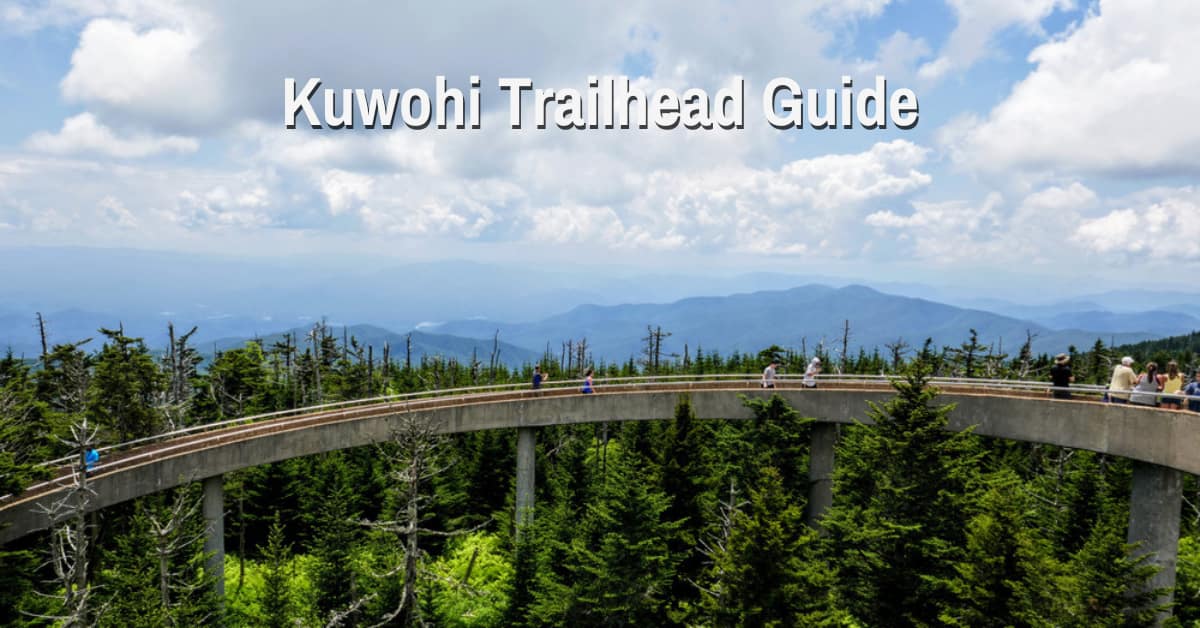Want a great hike with panoramic views and a wealth of history?
Come to the Kuwohi Trailhead, aka Clingmans Dome Trailhead, in the middle of the Great Smoky Mountains National Park.
This iconic location is situated on the Tennessee-North Carolina border and features a compact yet steep walk to one of the most magnificent observation towers in the Southeast.
However, this is not simply a hike; it is a hike through history.
Clingmans Dome was officially renamed as Kuwohi in 2023, meaning mulberry place, Cherokee language. The name change is meant to signify the rich heritage and the cultural value the place holds in the minds of the Eastern Band of Cherokee Indians.
Being the tallest one in the Smokies and Tennessee, Kuwohi is not only the object of a natural wonder, but also the representation of the revival and appreciation of Indigenous heritages.
1. What is Kuwohi?
Kuwohi, which is pronounced as Koo-woah-hee, means Mulberry Place in the Cherokee language. Kuwohi is more than a place name. It is a critical part of cultural recovery by the Cherokee people, a holy mountain that they had long known before it was re-named Clingman Dome late in the 1800s.
The Eastern Band of Cherokee Indians has been living in the Southern Appalachians for thousands of years and considers this land Kuwohi.
To them, the mountain was not just a mere mountain but a site that united them with their ancestors as well as nature.
Over the past few years, there has been an increasing demand to reclaim Indigenous names and identities, including Kuwohi, which were successfully renamed. It was not only the historical name, but also, and most importantly, the value of Indigenous knowledge and taking care of the land.
- This is named after Confederate General Thomas Clingman
- Renaming was an attempt to create a bigger indigenous advocacy
- Renaming the names is a reversion to the foundations and honor of those who initiated to look after the Smokies.
2. Overview of the Kuwohi Trailhead
Take the 1-mile out-and-back trail, not far away from Bryson City. It is a relatively difficult path with an average of 43 minutes of completion.
- It is one of the most frequented places to run and walk around, and so it can be expected that you will bump into other people in the process of exploration.
- During the months of April to November is the safest time to be on this trail.
- One of the most famous hikes in the Great Smoky Mountains National Park, the Kuwohi Observation Tower Trail (also called Clingman Dome) is highly demanded by tourists.
- It also reaches the highest point in Tennessee, as well as along the Appalachian Trail.
- Kuwohi offers some amazing 360-degree panoramas in the Smokies and of the stunning Spruce Fir Forest.
The area has a large parking area, a visitor center, and some scenic pullouts. Though the trail is asphalted, the NPS site does not regard this nature trail as accessible to wheelchairs.
Trail Information
| Distance | 1 mile (round-trip) |
| Difficulty | Moderate |
| Time to Reach | 43 minutes |
| Elevation | 103 m |
| Dogs Allowed | No, dogs are not allowed here |
| Kid Friendly | Yes |
3. The Kuwohi Observation Tower
Kuwohi is the tallest mountain within the Great Smoky Mountains National Park and towers at 6,643 ft. It tops Tennessee and is the third-highest mountain in the eastern part of Mississippi.
There is an observation tower at the highest point with a 360-degree view of the Smokies and beyond, which one will have after climbing a half-mile steep walking climb to the tower at the top of Kuwohi.
At the top of Kuwohi is the Kuwohi observation tower, which is a UFO-like concrete building. Constructed in the year 1959, the tower was rather an adventurous architectural step back then, and it is perhaps one of the most recognizable features of the park.
On clear days, you can see more than 100 miles. The dome may be 10-20 degrees cooler in temperatures than the surrounding lowlands. Wear multiple layers and do not forget to bring a jacket even in summer.
Tower Highlights:
Design: Coil of ramp to viewing platform
View: Have up to 100 miles of view across the Smokies on a clear day
Among other places, some visitors revisit at night to stargaze and to observe the Milky Way (bring a flashlight!).
Note: The visibility is weather and time-of-day-dependent. Fog and haze are frequent.
Directions to the Clingmans Dome Trailhead
There is a parking lot close to the Clingmans Dome Trail located on the street of Bryson City, NC, although Clingmans Dome (kuwohi) is found near the city of Bryson City, NC.
In the area of Cherokee, North Carolina, to arrive at the Clingmans Dome Trailhead, continue through the Great Smoky Mountains National Park using US 441 North (Newfound Gap Road).
Note: Just before Newfound Gap, turn left onto Clingmans Dome Road and drive 7 miles till you arrive at the parking. The parking lot is located at the very end of the trailhead, which can be found in the middle of it.
If you are coming from Gatlinburg, you should drive along the US 441 through the Great Smoky Mountains National Park to the Newfound Gap.
Soon after crossing the Newfound Gap, turn right onto the Clingmans Dome Road and drive 7 miles on it to the parking lot that doubles up as the trailhead. This road is a specialized entry to Clingmans Dome. Some of the major attraction sites are the Newfound Gap and the Clingmans Dome Road, which offer breathtaking views of the mountains.
4. Hiking Tips for Visiting Kuwohi Trailhead

The thin air combined with rapidly shifting mountain weather and the relentless incline make it a necessary occasion to arrive ready.
The following are step-by-step hints as to what to wear, what to carry, how you can hike safely, and when to hike.
What to Wear
Kuwohi can be bright and sunny one second and cold and rainy the next second, depending on the season, time, and even hour.
- Even in summer, it is a good idea to wear a base layer that wicks moisture and have a microfiber or puffer jacket with you.
- The trail is paved, but nevertheless very steep and usually very wet or slippery because of fog and condensation. Wear good hiking shoes or boots that have a good grip. Do not wear flip-flops or old sneakers.
- Carry a small windbreaker or rain jacket, where appropriate, during the spring and fall seasons. Sudden weather changes at 6000+ feet are unpredictable, and they may cause fog, rain, or strong winds within seconds.
What to Bring
Water- Min 1-2 liters per person. No drinking water can be found at the trailhead or on the summit.
- Energy bars, trail mix, or fruit will help keep your energy up after the steep section.
- Hiking Poles are optional, but useful to people with knee sensitivity or balance issues. It is also possible that poles can make the descent easier.
- Carry a hat and sunglasses to safeguard against the harsh rays of the sun, particularly on high altitudes.
- Binoculars are excellent for seeing birds or distant mountains from the observation tower.
- Bring a camera, the sights are superb, and taking photographs is one of the favorite things to do here.
Pace Yourself
When it reaches elevations of 6,643 feet, you can experience shortness of breath, and this can be a problem, especially when you are not used to high elevation.
- Rest a lot and do not make the climb too fast.
- On the way, there are some benches where you can take a rest.
Start Early
The parking lot gets loaded at Kuwohi, particularly in the period of June to October, and also during the fall.
- Campers should aspire to be there earlier than 9:00 AM so that they can get a place and have a less crowded hike.
Avoiding Crowds and heat
During the summer, the afternoons will be hot and very busy.
- The path is not very shady, and there are no water fountains, so going out in broad sunlight may wear you out.
Weather Awareness
Never go up until early, checking the forecast.
- Thunderstorms usually happen during the summer time, and lightning is particularly hazardous in high-altitude areas and open areas such as an observation tower.
Best Time to Visit
Kuwohi during spring (April to May) is a most lovely time of year to visit, as one can sense the trail coming alive with the presence of wild flowers and cool mountain air. It is a very placid experience in this season before the arrival of the summer crowds.
- The summer (June to August) is lush and long-dayed, as well as crowded and stormy in the afternoons.
- Autumn (September to November) is preferred because of fresh air, clear skies, and magnificent bluish foliage, which is the most popular season to visit.
- Winter (December to March), Roads are frequently closed during winter months because of snow, and access to the trails is either restricted or non-existent.
It is ideal to hike between late September to early November during the fall when the weather is clear and the fall colors are at their peak.
5. Nearby Attractions to Explore
The Kuwohi Trailhead is located in one of the most picturesque and culturally diverse regions of the nationwide park of Great Smoky Mountains.
While you are making your plans to visit the top and famous observation tower on your hike, it could be great to add some experience to your tour and visit some of the following nearby destinations, each with a different insight into the Smokies.
Newfound Gap ( 15 minutes)
Newfound Gap is the most popular scenic overlook in the park, which is approximately 7 miles east of the Kuwohi Trailhead. The mountain pass is in the Tennessee-North Carolina state line and is as high as 5046 feet above sea level, with a panoramic view of the two states.
Mingus Mill ( 30 minutes)
The Mingus Mill is a historic water-powered grist mill in operation today, built in 1886. It has a beautiful flume and serene surroundings, and makes a good place to take photographs and learn about the ingenuity that the Appalachians.
Oconaluftee Visitor Center (45 minutes)
Not only a visitor center, it is a portal to the area’s rich history, splendid landscapes and extraordinary wildlife. Inside the visitor center, exhibits illustrate Native American life and the early European colonization periods through the Civilian Conservation Corps and the establishment of the national park.
Deep Creek Area ( 1 hour)
Nestled just beyond Bryson City and a little less than an hour away, Deep Creek is known as the friendliest star of hiking waterfalls, places to picnic, and riding tubes in summer. Three scenic waterfalls in one loop (Juney Whank Falls, Tom Branch Falls, and Indian Creek Falls) are all on relatively shorter trails in the loop.
The Road to Nowhere ( 1 hour 10 minutes)
This unusual site is only a brief drive outside of Bryson City and is noted as a carryover of a highway project that just received too many controversies. Formally known as Lakeview Drive, the otherwise so-called Road to Nowhere stops at a tunnel, which has since become a cloudy, photo-worthy hike and iconic piece of history.
6. Where to Stay: Elk Hollow Resort in Bryson City
After a long day spent exploring Kuwohi Trailhead, Elk Hollow Resort is the perfect place to relax.
- Guests can unwind around the fire pit or bask in the resort’s peaceful ambience and modern conveniences.
- This place suits couples, families, and single travelers who want comfort and convenience.
- Employees provide hiking tips and information about routes
Conclusion | Kuwohi Trailhead
The Kuwohi Trailhead is not just an entrance into a beautiful viewpoint. It is an experience of cultural memory and a mountain top experience that encounters Appalachian beauty and a salute to the Cherokee roots of the earth.
Kuwohi features an easy-to-walk paved path, the panoramic vistas of the historic observation tower, and the rich natural setting.
It is becoming an excellent choice for every Smoky Mountains visitor, no matter their intentions of capturing fall colors, finding sunrise shots, or getting acquainted with the Indigenous history of the mountain.
At the end of your hike, go to the comfort zone at Elk Hollow Resort, where the magic is still in the serene mountains of Bryson City.
What are you waiting for? Book your stay now!
FAQs | Kuwohi Trailhead
1. What is Kuwohi Trailhead?
Kuwohi Trailhead, formerly known as Clingmans Dome Trailhead, is a popular hiking destination in the Great Smoky Mountains National Park. It leads to the highest point in Tennessee and features a paved trail to a historic observation tower with panoramic views.
2. Why was Clingmans Dome renamed to Kuwohi?
In 2023, Clingmans Dome was officially renamed Kuwohi, meaning “mulberry place” in the Cherokee language. The renaming honors the cultural and spiritual significance of the mountain to the Eastern Band of Cherokee Indians.
3. How long is the Kuwohi Trail?
The Kuwohi Trail is a 1-mile round-trip paved trail. Though short, it is steep and typically takes about 40–45 minutes to complete.
4. What is the elevation of Kuwohi?
Kuwohi sits at 6,643 feet, making it the highest point in Tennessee and one of the highest peaks in the eastern United States.
5. Is the Kuwohi Trail open year-round?
No, the road to Kuwohi (Clingmans Dome Road) is generally open from April to November. It is closed during winter due to snow and ice. Always check the NPS road alerts before planning your trip.
6. Is Kuwohi Trailhead accessible by wheelchair?
Although the trail is paved, the National Park Service does not classify it as wheelchair accessible due to its steep incline.
7. Can I bring my dog to Kuwohi Trailhead?
No, pets are not allowed on the Kuwohi Trail. Dogs are only permitted in campgrounds and along roads in the Great Smoky Mountains National Park.
8. What is the best time to visit Kuwohi for clear views?
The best months for clear views are September to November. Fall also brings vibrant foliage and cooler, less humid conditions ideal for hiking and photography.
9. What should I wear and bring for the Kuwohi hike?
Wear layered clothing, good hiking shoes, and carry essentials like water, snacks, a jacket (even in summer), and a flashlight if staying for sunset or stargazing.
10. Where can I stay near Kuwohi Trailhead?
Elk Hollow Resort in Bryson City is a great nearby accommodation option. It offers comfortable lodging, fire pits, and easy access to hiking areas including Kuwohi and Deep Creek.



